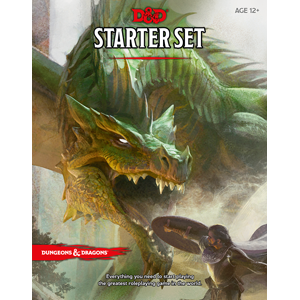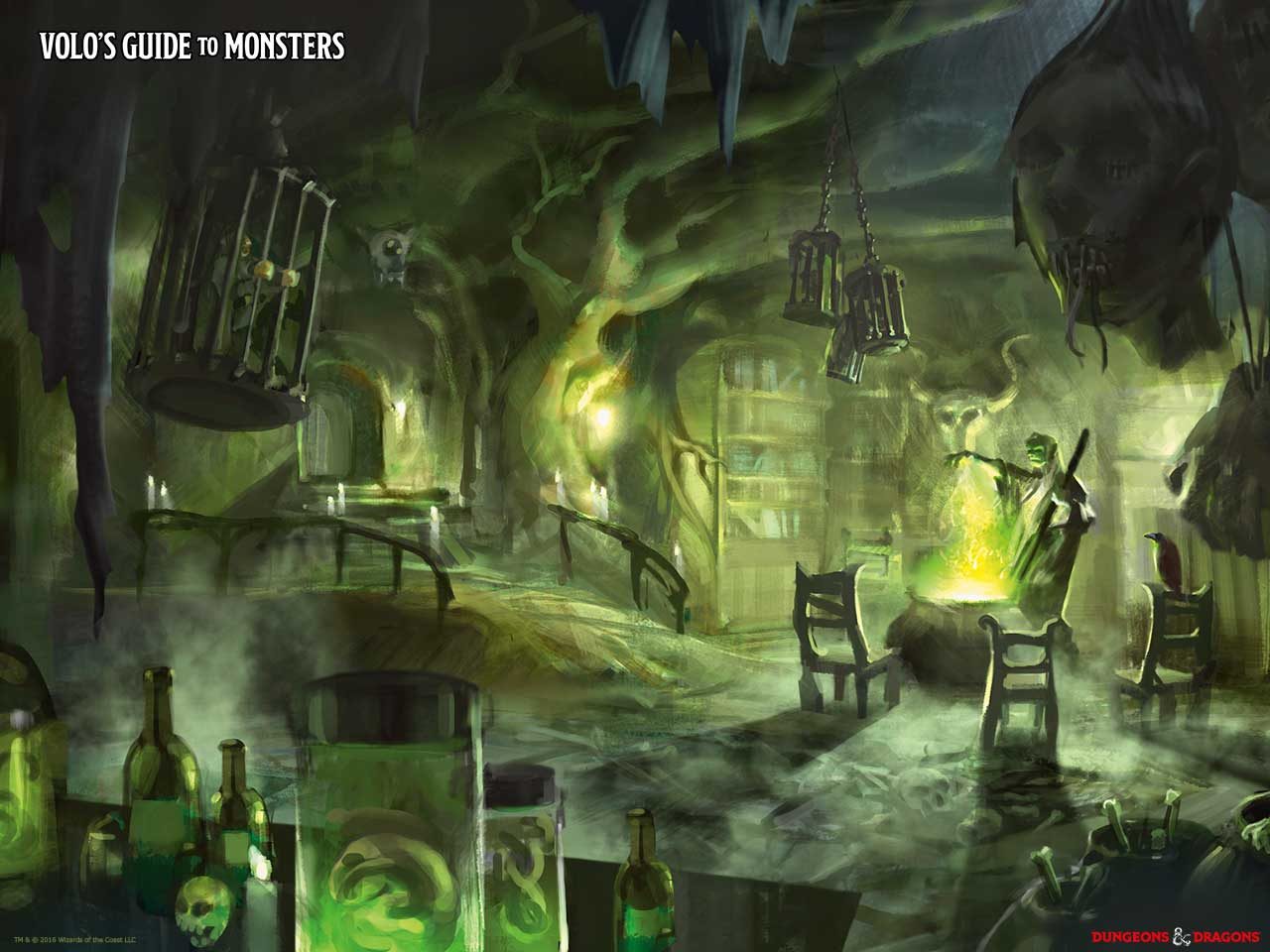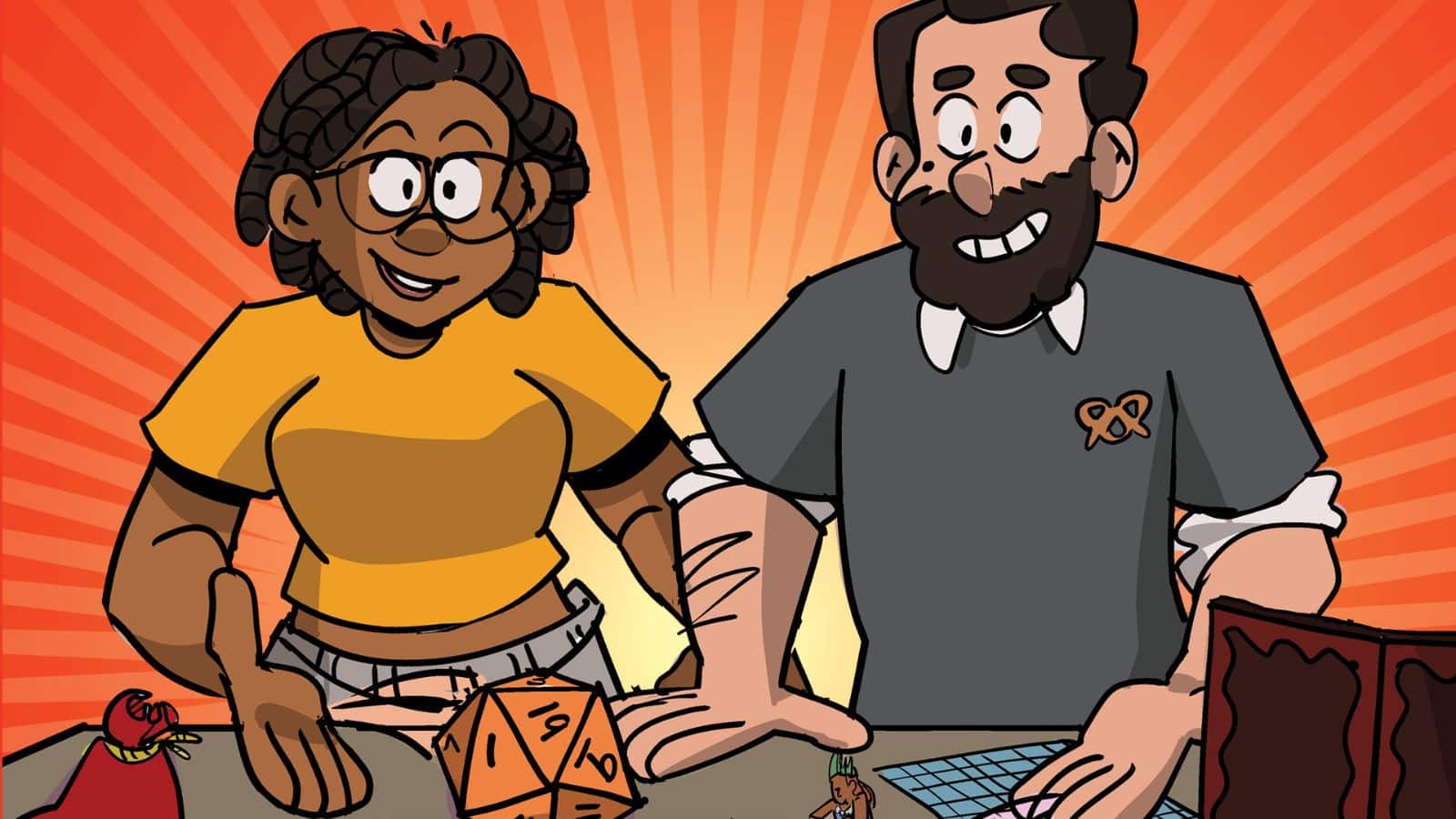By Andrew Dmytrasz
Playing Dungeons and Dragons for the first time is intimidating. No matter who you’re playing with, how many times you’ve practiced by yourself rolling dice and doing simulations, or how many times you’ve read the Player’s Handbook and Dungeon Master’s Guide, it’s nerve-wracking to sit at the table with other people when you are new to tabletop roleplay, hoping that you don’t screw up or say something wrong. Even if you’re not new to D&D and know how to play, if you’re playing with a new group, it can still be worrisome to figure out if you’ll get along.
So, how do you play D&D? No two campaigns are ever the same; even if you run the same campaign, the story will almost always turn out differently just based on how the Dungeon Master (DM) or Game Master (GM) runs things, or how the players and characters act. The GM will have one idea how the campaign will go, the players will have another idea, and the result is some combination of both.
Reading the Player’s Handbook is your best bet to learn how to play, but here’s a basic guide to getting started.
What you need
- DICE! Full sets are usually available for purchase in matching colors from your local game shop, or you can order online. It’s best to have at least one 20-sided die (1d20) and one or two six-sided dice (1d6 or 2d6), but some classes require other dice for things like hit points and combat. Thus, a full set is useful when you’re just starting out: 1d20, 1d12, 1d10, 1d%, 1d8, 1 or 2d6, 1d4.
- Your character sheet (see below)
- A pencil or erasable pen if you are using a physical character sheet
- A tablet, laptop, or phone if you are using a digital character sheet
- Snacks
How to create a D&D character

If you, your DM, and the other players in your adventure party are all new to D&D, you can also check out the Starter Set, which includes five pre-generated characters with character sheets. Easy, right? But if you want to get more creative, here’s the rundown. This post is meant to give you a brief overview of the different aspects to consider when making your character; it is by no means a comprehensive guide. For more information on how to make your own character from scratch, you can refer to “Chapter 1: Step-by-Step Characters” in the Player’s Handbook, or visit sites like OrcPub, aidedd, and fastcharacter.
Whether you make your own character or use a pre-made one, there are four things to consider when making your character for D&D: Class, Race, Background, and Alignment. Each of these things will affect your overall character, what languages they will know, what skills, tools, and weapons they are proficient in, and their stats. Proficiencies determine what skills or attributes your character excels at. All of this can also help shape your character’s backstory, which you can flesh out during game play.
1. Class
The class you are determines what type of job you have. The basic and most common ones, which can be found here, are fighter, wizard, cleric, rogue, and ranger. There are additional classes like barbarian, bard, druid, monk, ranger, artificer, and warlock, among others, as well as “homebrew” classes you can find on various D&D sites. Your class determines your fighting style, what type of weapons you will use, your armour, and your skills.
2. Race
Much like in real life, your race factors in your culture, background, and appearance. The most common races include human, elf, dwarf, halfling, gnome, and half-orc. Other races include dragonborn, tiefling, and more. There really isn’t any limit on what race you can be. Race will also determine what languages you will know, as well as your character traits.
3. Background
Your background can help shape your backstory, but also helps determine what skills and tools you are proficient in, as well as your languages. The different backgrounds include: acolyte, criminal, folk hero, noble, sage, and soldier. Your background can relate to your class, such as the fighter/soldier combo or the artificer/guild artisan combos, but you don’t have to tie these together. Get creative!
4. Alignment
We all know alignment memes, right? Those come from D&D. Your alignment determines your character’s morals, such as if they like to follow the law or if they would prefer to break it. This Geek & Sundry guide will give you an idea as to where characters in fandom line up, to give you a sense of how to approach this part of your character. There are also alignment tests all over the web that you can take to determine where your character falls: Wizards of the Coast have their own alignment test, as well as BuzzFeed and aidedd. The alignments are: Lawful Good, Neutral Good, Chaotic Good, Lawful Neutral, True Neutral, Chaotic Neutral, Lawful Evil, Neutral Evil, Chaotic Evil.
Certain races and classes tend to fall along certain alignments, but you can buck the system and do whatever you want, as long as it makes sense for your character!
5. Backstory
Now it’s time to get really creative. Pre-made characters have simple backstories, but you can still use a pre-made character and change the backstory; this is where you can really make the character your own. While they might be a fighter, or criminal, or cleric, you can determine why they’re like that and how they got there. This can create interesting tension during your campaign. Maybe a character doesn’t want to go to town because they aren’t interested, or because they’re worried they may run into someone from their past.
There’s no wrong way to make your character. You can think of your favourite character from your much-loved fandom and try to adapt them to a D&D character sheet. Want to play as a Harry Potter character? Check out the sheets someone else made for them here. Sailor Moon? There are character sheets for the Sailor Scouts as well. Want to play as a Pokémon? You get the idea. While it may not be an exact match, you can usually get something that is approximate to the idea you have in mind if the character sheet doesn’t already exist for them.
Another way to start is by looking at all the different races or classes there are and picking your favorite combo. You can change it up and have an unusual character — maybe a not-so-stealthy rogue, or a powerful halfling wizard — because ultimately, it’s all up to you.

Once you have your character, it’s time to go on an adventure! The best way to explain how to play D&D is to describe what usually happens during a session.
How to play D&D
Getting started
If you are starting a new campaign, the GM will give either a little or a lot of background information about the campaign and what task or challenge is set out before you. The GM might give you a reason as to why you have all been gathered here or ask each of you to come up with your own reason as to why you’ve come. They will usually give suggestions or at least options of places to explore or people to visit. The GM might ask everyone to introduce their character and backstory or let it be revealed during the campaign.
Following that, everyone will need to decide what course of action to take; for example, everyone can explore together or split up and check out different places.
Everything you do in D&D is determined by your character’s abilities and the roll of the dice. Depending on the combination of your Race, Class, and Background, you will get your ability scores for your six abilities (strength, dexterity, constitution, intelligence, wisdom, charisma). Your ability scores will determine the modifier for your abilities: For example, an ability score of 6-7 will give you a modifier of -2. You apply your modifier when you want to do an ability check.
An ability check is when you want to attempt an action that has a chance of failing. An ability check can be used in any number of situations: checking for traps, trying to charm or intimidate someone, or holding a door closed to stop enemies from breaking it down. When you make an ability check, you add the appropriate modifier depending on the task, which your DM will usually determine for you.
For example, if you want to try and intimidate someone into giving you information, an intimidation check would fall under Charisma, but if your Charisma modifier is low and your Strength modifier is high, you can ask to use Strength instead. You might tell your DM, “I want to intimidate this person by lifting something heavy, or break something to prove my strength.” You won’t always be able to roll an ability check to your advantage, but having a mix of stats and relying on chance is part of what makes the game fun.
As you explore and gather information, eventually a battle will take place. At the beginning of a battle, everyone will need to roll for initiative to determine the turn order of who acts when. The GM will role for the enemies and guide you through the fight.
After the battle is done, experience points might be rewarded (unless a GM prefers to give XP at the end of each session), and loot may be given out. Battles typically progress the story in some way. Then, more information may be revealed, and your next objective will become clear. You will follow, go to shops, talk to people and gather information about your quest.
In a session that continues an existing campaign, the GM will usually give a recap of what happened before and suggestions for where you can head to next. If you are in a town, the GM might ask if anyone wants to stock up on supplies, buy equipment, or sell anything.
If you are feeling nervous or underprepared, you can choose to read the Dungeon Master’s Guide, which will give you a sense of what your DM or GM might ask your character to do. You will get an idea of when and what dice you will need to roll for certain actions and for combat.
Still feeling uneasy? Ask the GM! A good GM should answer any questions or concerns you may have about your character or the campaign. If possible, you can ask your GM if they would be willing to run a short tutorial for you. You can also read the example below.
Here’s an example of what may happen during a session
You find a small wooden house in the middle of a forest; do you investigate it or leave it alone? What you could do is ask your GM if you can do a perception check to see if you can sense any traps or anything unusual about this house. Your GM might say that there isn’t anything worthwhile to investigate, or they may ask you to roll a D20 and add your perception modifier, which is on your character sheet. The GM will have assigned a number that must either be met or exceeded to see you succeed at the task.
In the case of this perception check, the GM has assigned the number 15 (they will never tell you what the exact number is, only if you succeed or fail). You roll the D20, add your modifier, and get a result of 14, but you are proficient in perception and can add your proficiency bonus, so your result is 16. Congrats!
Your GM tells you that there is something slightly off with this house; there is some magical energy in the air and you should be prepared. You decide to go and explore inside.
You enter to find a small bed in the corner, two swords hanging on the wall, and various books on a bookshelf. As you step inside, the door shuts behind you, the swords pull themselves away from the wall and float in front of you. You knew before entering the house that there was something unusual going on, so you are not caught off-guard by this. At this point, a battle will commence. Everyone will need to roll for initiative; players will roll D20s and add their initiative scores, which can be found on their character sheets. The GM will roll for the non-player characters (NPCs) and announce the turn order for the fight, with the highest roll going first and the lowest going last.
The GM announces that you get to go first, then the swords will go after. (GMs might roll for the enemies individually or as a group.) During your turn, you can use an action (such as a spell or attack), as well as a movement based on your character’s speed. You will announce what weapon or spell or attack you will want to use. Rather than going straight for your weapon, you may ask your GM if you can try overpowering the sword and trapping it in a blanket, or creating a spark to try burning down the house. GMs love when players get creative, so never feel like you have to always attack with your weapon. Maybe your character had all its equipment stolen and needs to improvise their weapon until they can track down whoever stole it.
Whichever way you decide to spend your action, you will need to roll a D20 to see if your action succeeds or not. If you decide to do something besides attack, you will have to explain it to your GM and they will assign a number based on the difficulty of your action that you must meet or exceed. If you do decide to attack with a weapon, you will need to roll a D20 to see if it hits or not. The number will need to meet or exceed the enemy’s armor class (AC). On your character sheet, your weapons, their attack bonuses, and their damage dice and type should be listed. The type of damage comes into play when either a character or enemy has a damage resistance to a particular type of attack.
In this example, let’s say you are using a great axe, which has an attack bonus of +5. You roll a 12, and add your attack bonus of +5 for 17 total. The AC of the flying sword is 17, but your GM will not say what the AC is, only if you hit your target or not. Depending on how long a fight is, you might get a good sense of what number the AC is. Since the AC is 17, you succeed in hitting one of the swords.
Now you roll for damage. In our example, the damage is 1d12+3 slashing. You roll a 1d12 and add +3 to the roll. For our example, let’s say you roll a 9, add in the +3 for a total of 12. The flying sword has a total of 17 HP (in most campaigns, monsters’ AC and HP levels will be the same, however a GM may alter it to make it stronger or weaker to suit the needs of their campaign). The GM will not say how much HP is left after your attack damage, but rather paint a word picture: “You have severely damaged your opponent and the sword cracks from handle to tip,” or “They look like they still have a lot of fight left in them, but that must have hurt.”
Back to our example: You manage to do a great deal of damage to the first sword. It wavers and floats closer to the ground, almost limping as it struggles to float. Now, the swords take their turns. The GM will roll for the sword to see if it hits you or not. The first sword rolls a 13 and has an attack bonus of +3 to hit (let’s say you have an AC of 17). So it misses you. The first sword you attacked is eager for revenge and lunges itself at you. Still weak from your attack, it misses as you dodge out of the way.
The second sword rolls a 15 and with the +3 attack bonus, the total is 18. The GM will confirm your AC and inform you that the attack hits. The second sword spins in place slowly, then builds up speed as it rushes towards you and attacks. The GM might roll for damage each time or use the suggested number. In our case the GM will use the same number to keep it consistent. You take five points of slashing damage; please mark it down on your character sheet. In the box with your Hit Point Maximum, you will mark your current HP after taking that hit.
The turn order goes back to the top again and starts with you. The battle keeps going until either all the players lose their HP or your enemies do. Let’s say you win this battle after going back and forth a couple more times. After the battle is done, the GM may award experience points and loot, or you can roll an investigation check to find your own loot. Following a battle, some or all of the players might be injured, in which case you will want to heal up. There are a few ways this can be done: take a short or long rest, ingest a potion of healing, or use magic if you or a teammate have healing spells.

A short rest usually lasts about two to four hours in game, which is the equivalent of taking a nap or break, and you can spend a hit dice (located on your character sheet below your HP box) to roll and recover some HP. A long rest is about eight hours in game, which is about the same as sleeping through the night (or during the day depending on what your party is trying to do), and you recover all your HP. There are different types of healing potions that will restore small or large amounts of HP, as determined by your roll. A basic potion of healing will be 2d4 + 2 Hit Points. You can also drink a potion during battle as your action, or give a potion to someone else in battle as your action. The other way to heal is through spells such as Cure Wounds or Healing Word. These can also be used in battle or afterwards.
Rely on your DM for guidance
One important thing to keep in mind is that every DM or GM will run their campaign differently and how they run it might not work for you. Similarly, the way other players or their characters behave might not work for you either. Please do not let this discourage you. Not everyone will get along with everyone, even while playing. If you find a GM that you don’t quite like, or players with whom you don’t enjoy playing, there is no harm in finding another group that works for you. Don’t stay in a campaign if the GM or players are making you uncomfortable. Tabletop roleplay games are supposed to be fun and enjoyable for everyone and if you keep looking, you will find a group that works for you.
If your GM gets mad at you for asking questions about your character when it’s your first time playing, that usually isn’t a good sign for the campaign itself. There are GMs out there who would love to help new players get into the game. Other players who have been playing for a while are also often open to helping new players making a character or to answering questions.
While it is beneficial to have read the Player’s Guide, it is long and detailed and no one expects you to have read the whole thing or to have it memorized. You can skim through it, and refer to it for specific questions you might have. People bring their copies to sessions all the time to either refer to it themselves or have it ready for other players who might need it.
Basically: Don’t be afraid to dive into D&D or another tabletop roleplay game, and advocate for yourself and your needs as a first-time player. If you’re campaigning with the right people, the rest should be cake.
Helpful Links:
- D&D Beyond
- Roll20
- Wizards of the Coast
- How to Build an Amazing Character for Your Tabletop RPGs
- RPG Character Building Tips for Beginners
- Make Your D&D Characters Easier to Manage with These Online Resources
- Tabletop RPG Essential Tools for Your First Session
- Tabletop RPGs: How to Get Started
- Interested in Dungeons and Dragons? Start With This Video
- The 4 best Improv Rules to Improve Your D&D Game
- Show Game Masters You Care with These Helpful Tips







